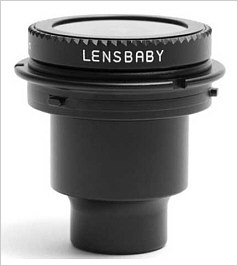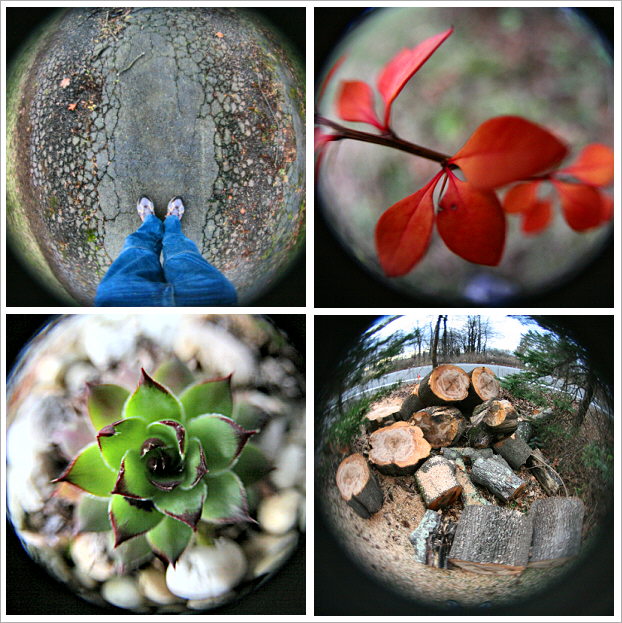

Lensbaby Fisheye Optics Review
 The Lensbaby Fisheye optic is designed to work with the Lensbaby Composer (and the Muse with a special adapter). It provides a circular image on a full frame 35mm camera with an angle of view of around 160 degrees. On a crop sensor camera the horizontal FOV is still almost 160 degrees (there's a slight cropping), but the view is no longer circular since the top and bottom of the circle are cropped off.
The Lensbaby Fisheye optic is designed to work with the Lensbaby Composer (and the Muse with a special adapter). It provides a circular image on a full frame 35mm camera with an angle of view of around 160 degrees. On a crop sensor camera the horizontal FOV is still almost 160 degrees (there's a slight cropping), but the view is no longer circular since the top and bottom of the circle are cropped off.
Unlike the dual and single element optics, the fisheye isn't really designed to be used with the tilt mechanism of the Composer since it doesn't really have a "sweet spot". It's really a conventional fisheye lens and is probably best used with the Composer (or Muse) untilted.
Like the other Lensbaby optics, aperture is controlled by inserting an appropriately sized disk with a central circular aperture. With no disk the lens is f4 and disks are provided for apertures of f5.6, f8, f11, f16 and f22. The front element(s) of the lens have to be unscrewed to change the aperture, but the process is quite simple.
Optical Tests
This first shot shows the image as recorded on a full frame DSLR (EOS 5D) as you can see just about the full image circle is recorded

In this second shot the image as recorded by an APS-C crop sensor camera (such as a Rebel T1i or EOS 5D/7D) is shown. As you can see the top and edges of the image are cropped out, though the full 160 degree image circle is recorded across the diagonal.

Just like most lenses, the Lensbaby fisheye gets sharper when stopped down, especially at the edges of the image circle. Below are 100% crops from the left edge of the image shot at f4, f8 and f16.

I compared the Lensbaby 12mm fisheye lens with two other fisheye type lenses I had available. The first was a Peleng 8mm fisheye lens made in the Ukraine. The second was a Cokin - 043 0.42x wideangle adapter mounted on a Canon EF 24/2.8 lens. This lens is really made for video cameras, but it does give a fisheye effect ona DSLR with a wideangle lens mounted. Before comparing the images note that the Lensbaby fisheye is around $150, the Peleng fisheye is around $390 and the Cokin adapter is around $45, so you'd expect significant differences in the image quality.
The images below show the full frame shots. Crops from these shots will be used for the comparisons.

The first comparison (all shots taken at f8, all crops 100%) shows the center of the images. As you can see all are fairly sharp. The difference in image scale between the 12mm and 8mm fisheye lenses is apparent.

The crops below show the extreme left edge of the image. As you can see the Peleng has wider coverage than the Lensbaby fisheye (which is due to their difference in focal length). The Peleng is sharper too. The EF 24/2.8 + Cokin 043 has about the same coverage as the Lensbaby fisheye, but the image quality is significantly worse.

The images below show a mid region of the image, about 75% of the distance to the edge. Again the Peleng shows the highest image quality and the EF24/2.8 + Cokin 043 is clearly worst with lots of blurring and chromic aberration. The Lensbaby fisheye comes in somewhere between the other two lenses.

But it's a Lensbaby...
 Of course absolute optical quality has never been the primary goal of lensbaby lenses. They are designed for artistic effects not ultimate sharpness. The lensbaby does give you the ability to tilt the lens (though with a fisheye this really doesn't do a lot). The Composer also allows the fisheye to focus down to within 1/2" of the front of the glass, which is much closer then the Peleng. This allows for much more creative fisheye closeups. It's difficult to get extremely close focusing with a conventional fisheye since even a 12mm extension tube (the shortest normally available) moves the focus point to within the lens itself!
Of course absolute optical quality has never been the primary goal of lensbaby lenses. They are designed for artistic effects not ultimate sharpness. The lensbaby does give you the ability to tilt the lens (though with a fisheye this really doesn't do a lot). The Composer also allows the fisheye to focus down to within 1/2" of the front of the glass, which is much closer then the Peleng. This allows for much more creative fisheye closeups. It's difficult to get extremely close focusing with a conventional fisheye since even a 12mm extension tube (the shortest normally available) moves the focus point to within the lens itself!
The additional edge blurring of the Lensbaby Fisheye may be desirable in these circumstances in order to diffuse the background more.
• More information - Lensbaby Composer and other Optics
Conclusions
If you already have a Lensbaby Composer (or Muse), then the Lensbaby fisheye is a reasonable way to get a fisheye lens. Probably the least expensive traditional fisheye is the Peleng 8mm lens, made in the Ukraine. It's a full frame fisheye with a 180 degree coverage, but it costs around $390, which is more than 2.5x the cost of the Lensbaby fisheye. The low cost alternative is a fisheye adapter which fits on the front of a conventional lens. I've used a Cokin 043 wideangle adapter on a 24mm lens to give a fisheye effect. The Cokin is really intended for video cameras and the image quality isn't great, but it only cost around $45.
The Lensbaby fisheye is midway between the wideangle adapter and Peleng fisheye both in price and image quality as can be seen from the sample images. As I said, if you already have a Composer or Muse then it's certainly worth considering. The image quality is quite good if you use one of the smaller aperture stops. If you don't already have a Lensbaby lens and don't want to use the Lensbaby system for other special effects, then a dedicated fisheye like the Peleng may be a better buy if you intend to do a lot of fisheye work. The wideangle adapter is cheap if you already have a 24mm lens, just want to play around with the fisheye effect and don't care about image quality.
Perhaps the most inconvenient aspect of the Lensbaby fisheye is the fact that to change aperture you have to take the lens apart and change the aperture disk. While this is easy and takes under 30 seconds in the field, it's still a bit inconvenient if you want to change apertures a lot. But if you're already a Lensbaby fan you'll be used to that and other features of the system (such as close focusing) may make up for the inconvenience of aperture disk swapping!
If you found this article interesting, please tell others about it...
Lensbaby Fisheye Samples
Here are some sample shots from the Lensbaby Fisheye. I've cropped them square to to save space. Any lack of artistic appeal is much more my fault than that of the lens! All were taken using an EOS 5D.

Lensbaby Fisheye Optic Specifications
